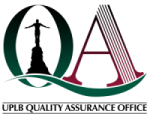On the last day of “Self-Assessment Report (SAR) Writing Training Seminar”, Dr. Benjamina Paula G. Flor, through her poem entitled “SAR is Not Char”, provided a recap of what transpired during the shared the journey of the College of Development Communication (CDC) in writing their own SAR, and provided tips on how to champion SAR writing.
Dr. Flor is a member of the CDC Quality Assurance Committee.
The four-day training seminar was conducted by the Quality Assurance Office (QAO) on Oct. 28-29 and Nov. 3-4 via virtual conferencing.

SAR is not char:)
In the SAR context, however, Char is a mnemonic which stands for Comprehensive and Hopefully Approved Reportage.
Thank you for giving us an opportunity to go through this learning activity of assessing our own curricular integrity.
It has come as a revelation that quality, as we perceived it, can be attached to a name because we are UP.
Gone are the days of enjoying the tatak UP branding without benchmarking what others have done or without a standard that can be vetted on or measured against carried out externally to be at par or even better than others as what Director Nina Cadiz had put emphasis.
Dr. Rose Eusebio who started with the end in mind turned Kris Aquino an exemplar of how to engage learners online which all of us became fans in an instance.
Our conviction that UP education is of high quality will not hold ground if we do not align with the needs of the times. Alignment, as the word for this four-day training does not only refer to our curricular maps but should be holistically crafted especially the outcomes to be achieved, according to Dr. Myra Borines. Examples of curricular maps were shown as best practice had we earlier known critical path direction would not have been etched in stone.
Sitting on the accolade that UP is the best can be solidified if our programs can prepare our students for lifelong learning going beyond employment to entrepreneurship based on Prof. Arlene’s tips.
Our openness to embrace outcomes-based education as exemplified by Doc Jomar and Doc Gumasing came as a bling-bling on how we assess students through quizzes or oral exam, portfolio or when to give a cinco, after all, we determine as faculty members what skills and knowledge or competencies students should be equipped with to meet the demands of being gainfully productive as giving back to the nation who paid their tuition.
Prof. Codilan stressed the role of the academic staff in ensuring quality outcomes through proper student-faculty ratio, computation of which was confusing a bit. However, computation will be made easy through a ready excel template that we all can manipulate as promised by Doc Nina Cadiz.
Prof. Leila Africa described the scope of student services and if admin staff are properly trained could take on administrative functions that will relieve the faculty of doing line assembly.
Doc Jovy talked about the learning environment for without it student education will not be complete. Our facilities and structures are classic but with the pandemic or the forthcoming blended learning pedagogy, immersive technologies like augmented or virtual reality should be part of our vocabulary.
Capping the training is Dr. Dorado’s outputs and outcomes which all boils down to what we have done as proof of quality which is our responsibility.
While CDC had its first AUN recognition in 2015, this training provided ample tips and strategies on how to write the SAR this time around. We were walked through the process step by step to hasten the SAR writing, which presumably stop us from swearing. Unlike before where we have to discuss and interpret every criterion only to find out we had a wrong interpretation. From 11 to 8 that sounds great but in reality, the three were tucked where they should be. Lesson learned is to store our data in an online repository like Google Drive and not in hard copies that are neatly bound kept in the dean’s office made available to the evaluating committees. Now, links to proofs are mandated just make sure these are properly tagged and labelled. Knowledge management must be considered since quality assurance could not take a chance.
Of course, challenges will always be there like the tracer study that we have to bear. Graduates do not readily answer the Google forms that come their way. Employers or HR managers may hard to come by either. Long questionnaires will surely be ignored but persistence and patience may just be our license. Sampling is key according to Doc Zita don’t be shy statisticians are on standby.
The remaining months of the year may not be enough to gather data from graduates and their employers especially with barriers like pandemiya. Submitting the SAR as scheduled however must be completed. We can continue data gathering and eventually get ready for AUN scrutiny. Next school year would be more likely to do exit surveys in January. After six months, investigating employability may come in handy.
It would also be a challenge to gather data this time because many lost their jobs due to the pandemic which may not be a true indicator of social mobility and their capacity.
Indicators for lifelong learning maybe difficult to identify coz attribution to the degree may have nothing in common. UPCA formula must be explained and written in full to standardize what colleges have to employ as well as student support services that the university had painstakingly put in place.
But the real challenge is to start somewhere somehow right now for if we won’t we will never know if we ever got there or have gone nowhere. Let’s start self-analyzing and remember that honor and excellence as our mantra mean quality that we have to adhere and live up to today and every day. Thank you.
